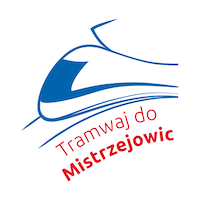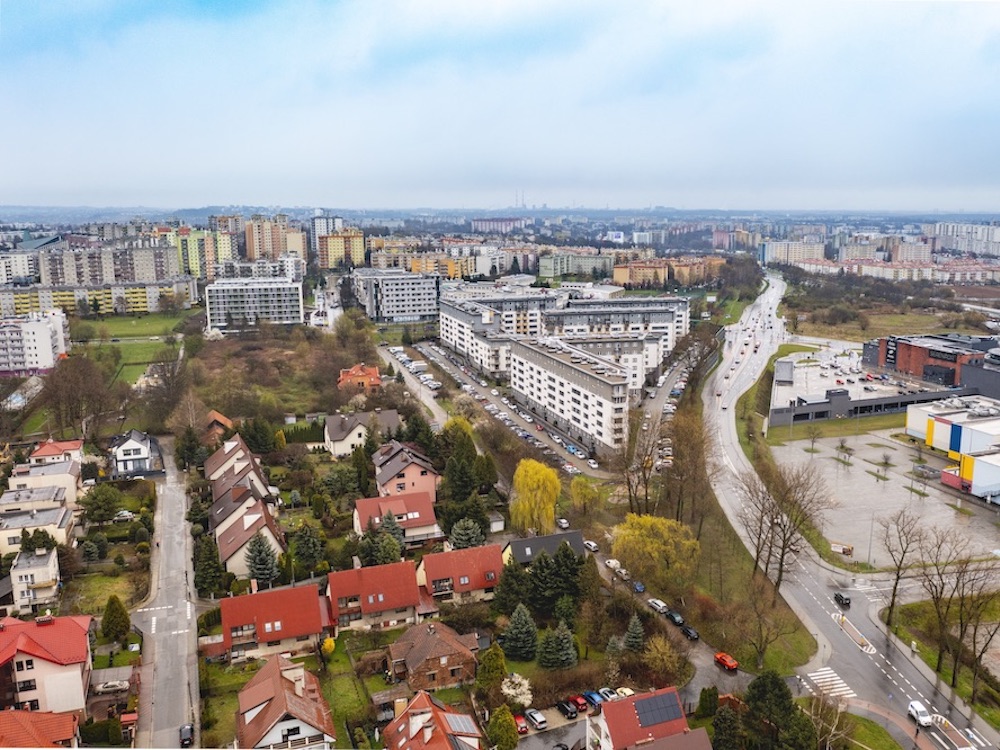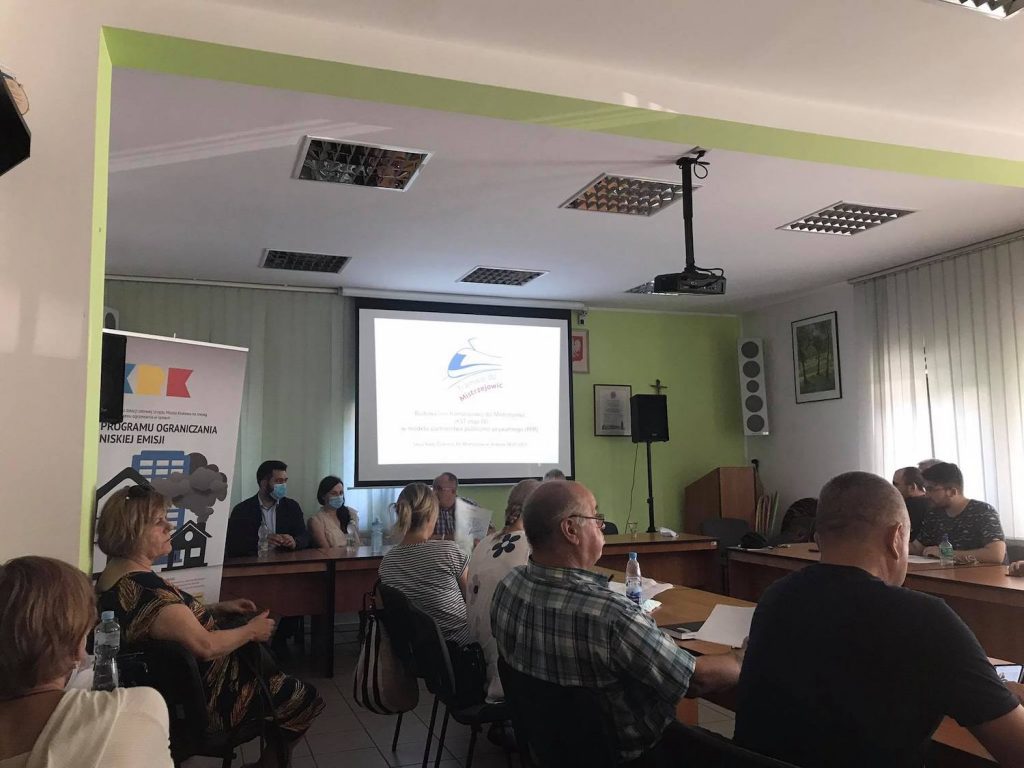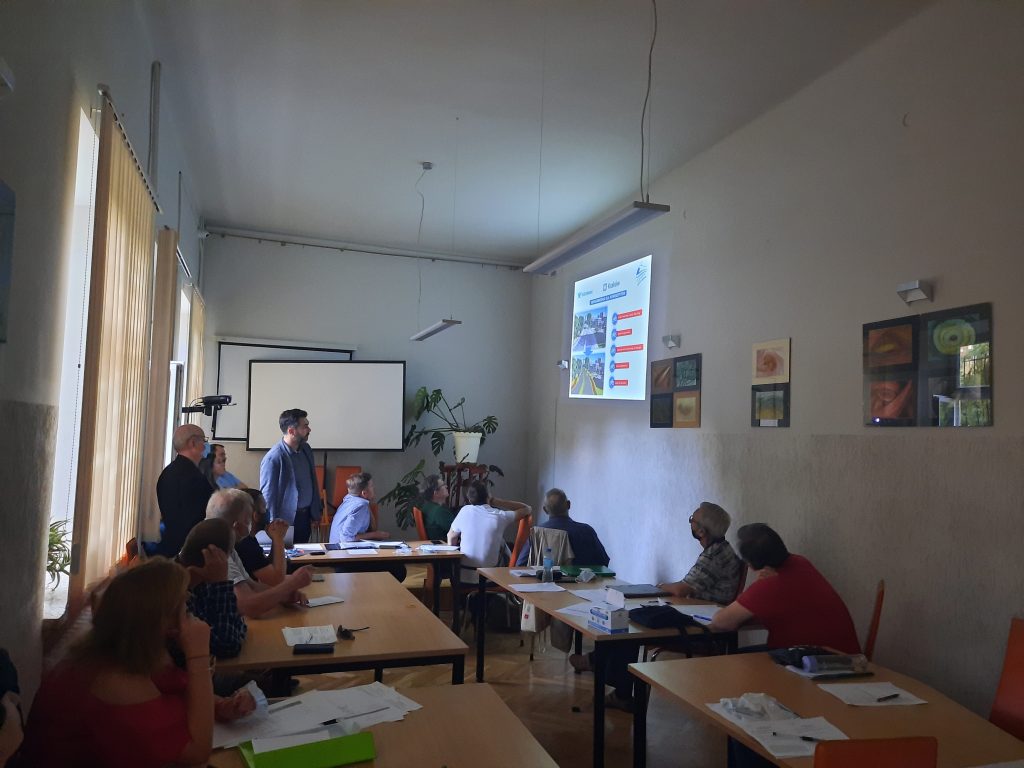In the first and second week of July, the designing team composed of representatives of the private partner, the public entity and the designer of the investment project attended sessions of Councils of Districts III and XV. Below, we present questions asked at the meetings and answers to them.
1. In Meissner Street, heat network has been replaced recently – will the tram road run above it?
Answer: The heating main in question is to be adjusted. The conditions for adjustment received from MPEC, where the need to increase the diameter of this main was indicated, are being verified. The final scope of adjustment is yet to be determined. The consultation process between the employer-contractor and MPEC regarding the scope of works is in progress.
2. Where can be the package of designs with all parts of the designed road be found?
Answer: The work package of the building plans was submitted to the bicycle policy audit of Construction of KST tram road, stage IV (Meissnera Street – Mistrzejowice) – Public Transport Authority in Cracow (ZTP Kraków) (mobilnykrakow.pl). It is not the final version of the design; it will be subject to further changes and corrections.
3. In Młyńska and Meissnera Streets, traffic was rearranged last year – cars park on the right-most lanes. Does the width of those lanes has to be also 3.5 m according to the new design?
Answer: The possibility of narrowing the outer lanes to the width of parking spaces was analyzed, however, both the master plan and the development plan, which is adjusted to the planned traffic volume and development of areas of neighboring estates, provide for two traffic lanes at this location. The situation after reducing the number of traffic lanes is being monitored; with the current traffic volume, this solution is efficient but potential narrowing of lanes would fully prevent their use for traffic in the future. The most probable solution is maintaining the current scope – that is, two 3.5 m wide traffic lanes and closure of the outer lane by means of visual narrowing and introduction of parking function under traffic arrangement. The permanent traffic arrangement will be developed at a later stage of the project.
4. It is said that a concrete highway will be constructed in Młyńska Street. How to calm the residents?
Answer: In general, the roadway span will be kept between the existing curblines. Only in the area of boarding platforms, the roadway slightly moves away outward. There will be no additional traffic lanes constructed. Given the social expectations though, the plan provides for widening of sidewalks and addition of bike paths, therefore, the land take area on the outer side of the roadway will be slightly widened. The main objective of the project is construction of a tram road.
5. Is it possible to keep trees in Meissnera and Młyńska Streets?
Answer: Boundaries of the land take area for the project are being verified. The tram route will run on the vegetated strip which implies a conflict with the existing trees. If the predevelopment plan confirms the possibility of transplanting them, they will not be cut down, but moved to another location. If the dendrological analysis however shows that condition of a specific tree is bad, it will have to be removed. Compensation plantings are planned. The same applies to vegetation on the outer part of the roadway, where there can be conflicts in the case of alteration of e.g. buried services. The private partner is open to discussion and cooperation with the Municipal Greenery Authority (ZZM).
6. Can the heating pipes be relocated directly under the bike path, which would enable planting of trees in the vegetated strip on the outer side of the path? At present, there are buried utilities everywhere under green areas which makes planting of trees impossible.
Answer: The guidelines are clear: as much greenery as possible has to be maintained and as many new areas for vegetation as possible have to be determined within the area of the project. Since the surface area of green space is tiny, the designer strives for such design solutions, including locating utilities in such a way that future plantings are possible to the largest extent.
7. Will the designer avoid meanderings of bike paths and walkways to prevent potential collisions?
Answer: The aim of the project is to minimize the risk of collisions and to construct bike paths with a safe layout agreed upon on the bicycle policy audit and by the Municipal Traffic Engineer. All crosswalks through the paths will be signposted. The designed width of bike paths is 2.5 m and of walkways – 2 m, which can reach even 4 m at critical points, e.g. at intersections.
8. Will the tram traffic between Mogilska Street and Jana Pawła II Avenue be suspended due to works carried out at the intersection with Meissnera Street? If so, for how long?
Answer: A detailed schedule of works is being prepared. Traffic closures cannot be avoided given the scope of alteration of the intersection.
9. Does the project provide for introduction of a fourth tram route in Lema Street?
Answer: The contract provided for the performance of an analysis of the possibility of opening the fourth route already now, but the revised traffic analyses indicated that capacity of this intersection would be significantly limited if it is opened. The overriding objective of KST IV project is to open the tram road to Mistrzejowice as soon as possible. Therefore, it has been decided that the route in Lema Street will not be addressed now and that justness of constructing the intersection at two levels will be analyzed at the stage of proceeding the project.
10. Is there any chance to change the location and type of noise walls on the northern side of Jana Pawła II Avenue? At present, they are non-transparent, block cyclists’ view and pose a significant risk of collisions with cars. In general, residents of the district expect that application of noise walls be limited to minimum – they prefer trees.
Answer: The designer is carrying out a detailed acoustic analysis on the basis of which adequate noise protection measures, compliant with the applicable provisions, will be selected. Wherever the new roadway layout requires that noise barriers are dismantled, they will be reconstructed afterwards. In other cases, they will remain in place. Currently, reflective noise barriers are usually used. As regards the scope of the protection, it will be based on the analyses. If the tests indicate that it is necessary to apply a measure providing acoustic comfort inside the buildings, such a measure will be designed.
12. Why cannot the tram road run on viaducts through Młyńskie roundabout?
Answer: The distance between Młyńskie roundabout and Polsadu roundabout, under which a tunnel is designed, is too small to bring the road from -2 level to +1 level. Such a solution would not allow keeping limit values of the track bed gradient permitted by regulations. The second aspect is noise abatement and environmental impact.
13. Does the option with the route running at -1 level through Młyńskie roundabout decrease the scope of land take compared to the above-ground option?
Answer: Due to the necessity to stop the tram on the roundabout island, the roundabout had to be widened in the above-ground option. If the track bed is moved to -1 level, the traffic circle can be made significantly smaller.
14. What is the probability that the option with the tram road at -1 level at Młyńskie roundabout will be executed?
Answer: Contractual provisions regarding the performance of the contract, including introduction of changes to the project, are very rigid. A change consisting in constructing the tram road at -1 level affects the scope of performed works; at present, the so-called change order is being analyzed. Once the cost of those works and the additional time needed for their performance are estimated, the city will make a decision on the selection of the option. City councilors have to consent to additional costs. From a technological viewpoint, such an option is feasible.
15. Is such a large number of traffic lanes needed at the entry from Pilotów Street to Młyńskie roundabout?
Answer: The number of traffic lanes arises directly from the layout of a turbo-roundabout. At the entire roundabout, 2 basic traffic lanes are being designed, and the other lanes will be used to distribute traffic. It is not equivalent to widening of the roundabout but it serves only as a facilitation of traffic at the roundabout, e.g. for buses making a U-turn there. Traffic analyses, which will provide an answer to the question, whether the number of lanes can be smaller or traffic can be reorganized, are being verified. It is worth mentioning that the project is calculated for the next 20-30 years.
16. How will kindergarten No. 162 be accessed?
Answer: There will be no access from Lublańska Street. Due to a very large difference in height and the resulting threat, the existing access way will be eliminated. Access to the kindergarten will be provided with the use of estate roads.
16. Will buses drive on the track bed?
Answer: No. Giving up this solution will enable application of green trackbed technology to the maximum possible extent. Instead of traditional grass, sedum mats will be used on the track bed which are characterized by aesthetic values and do not require mowing.
17. Does the intersection at the location of Barei roundabout have to be so large?
Answer: Traffic analyses forecast large traffic loads at this location. The city is drawing up documentation for construction of Iwaszki Street which will constitute a link with 29 Listopada Avenue. This implies that significant traffic will be led towards Strzelców Street. After the final extension of the traffic system in this area, the entry of Strzelców Steet will require widening. During the designing works, the possibility of keeping the existing layout of Barei roundabout will be analyzed.
18. Will the employees and guests of Quattro Business Park be able to exit the complex through residential developments to Dobrego Pasterza Street?
Answer: No new junctions with Dobrego Pasterza Street are planned.
19. Will the direct link between Krzesławicka Street and Dobrego Pasterza Street be maintained? Can at least the right turn lane be kept?
Answer: Giving up such a link was determined by the need to limit car traffic led directly onto the intersection with the tram road. Instead of this link, a turning head will be created. Those solutions will limit traffic along Krzesławicka Street. While implementing the tram project, Kraków Municipal Road Authority will address the issue of the crossing with Aliny Street, which – according to the legal state – should be a general access road, and of the junction with Brzechwy Street. Those routes will be able to be driven by car freely and conditions for the residents will improve.
20. Residents are against the opening of the link through Brzechwy Street to cars. Can it be given up?
Answer: Arrangements with the Municipal Traffic Engineer will provide an answer to the question whether this route can be included in a traffic-calmed zone once it is opened to car traffic.
21. What solutions will be used so that Krzesławicka Street does not become an illegal park&ride zone?
Answer: There will be no possibility of entering Krzesławicka Street from the side of Dobrego Pasterza Street.
22. Could the tram run at -1 level in Dobrego Pasterza and Bohomolca Streets?
Answer: A premetro study provides for a new tram road further down Dobrego Pasterza Street, where over-ground route is planned. Premetro will not run further along Krzesławicka Street, which is one of the arguments to give up the underground route at this location. Apart from it, underground tram road at such a long section would have a huge impact on the project costs which would jeopardize project implementation. Especially, given such large ground level differences which we face in this area.
23. Once Domosfera II estate is built, there will be new users of Krzesławicka Street. What then?
Answer: The city is in the process of arrangements with the investor regarding organization of vehicle access ways for this new estate. All entities which have given their opinion on any solutions so far, have expressed their objections to letting traffic from this development onto Krzesławicka Street. An access point onto Bohomolca Street is being designed, therefore, egresses from garages are being designed also in that direction.
24. Would it be possible to move the stop located in Bohomolca Street from the level of the intersection with Kniaźnina Street to the level of the intersection with Marchołta Street, so that the stop in Kurzei Street can be given up?
Answer: This proposal was deemed by municipal entities worth considering. An analysis of access paths to stops, given the distance acceptable in Cracow which is 400 m, as well as an analysis of impact on transport organization were conducted. Conclusions of those analyses led to the decision to give up the change in the location of the stops in this area. From a technical viewpoint, they would be feasible, but they are not acceptable from the perspective of organization of access to public transport from neighboring estates and schools.
25. Won’t the high number of crosswalks in Bohomolca Street the disturb flow of traffic?
Answer: The overriding guideline for the contractor is to give priority to the tram road. The traffic lights system will be adjusted to the tram needs. The number of crosswalks results from the urbanization level of this area. Traffic analysis will determine where traffic lights will be necessary.




